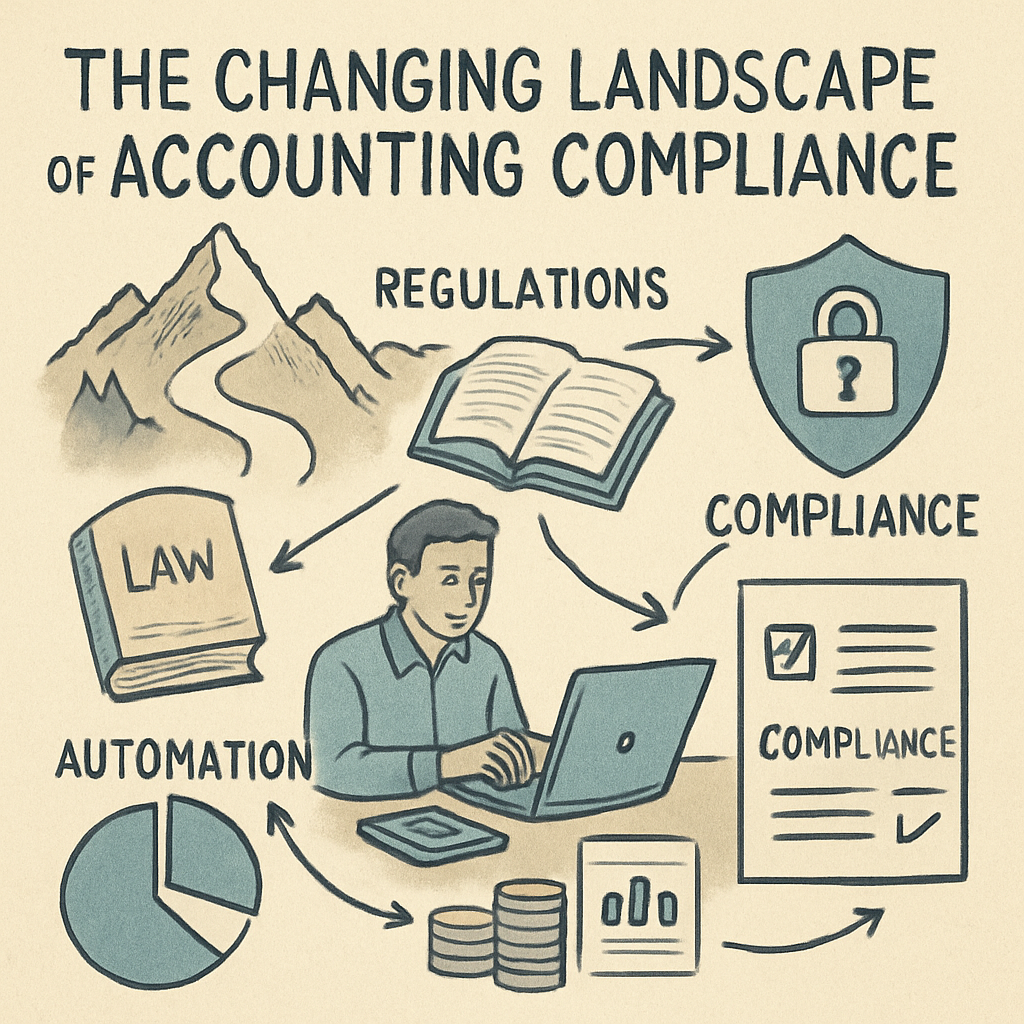Navigating Regulations: Automation in Accounting Compliance
Navigating the complex world of accounting compliance is no small feat. Regulations are ever-changing, and keeping up can be daunting.
Accounting firms face increasing pressure to ensure compliance. This is where automation steps in as a game-changer.
Automating compliance processes can significantly reduce human error. It offers a streamlined approach to managing regulatory requirements.
Accounting technology is at the forefront of this transformation. It provides tools that make compliance management more efficient.
Firms can benefit from real-time monitoring and reporting. This ensures that they remain compliant with the latest regulations.
Automation also frees up valuable resources. This allows firms to focus on strategic tasks rather than manual compliance checks.
The integration of compliance automation can lead to cost savings. It enhances efficiency and improves client satisfaction.
In this article, we explore how automation is reshaping accounting compliance. Discover the benefits and best practices for implementation.
The Evolving Landscape of Accounting Compliance
The landscape of accounting compliance is continually changing. New regulations and standards emerge, influencing how firms operate. Staying current with these changes is crucial for maintaining compliance.
Accounting firms must adapt to this evolving regulatory environment. Failure to do so can result in penalties and damaged reputations. As regulations grow more complex, automation becomes a vital tool.
Automation helps firms navigate this complexity by streamlining compliance processes. This ensures that requirements are met efficiently and consistently. It offers a proactive approach to managing compliance, rather than a reactive one.
Key elements shaping this landscape include:
- Increasing regulatory scrutiny
- Growing complexities in tax laws
- Rising importance of data security
Accounting firms that embrace these changes can gain a competitive edge. They can operate more efficiently and maintain client trust. Compliance automation assists in achieving this by reducing the risk of errors.
Why Compliance Management Matters for Accounting Firms
Compliance management plays a vital role in accounting firms. It is the backbone of credibility and trust. Clients depend on firms to adhere to strict regulations.
Firms must prioritize compliance to avoid legal and financial penalties. Effective compliance management also helps maintain a firm’s reputation. This is crucial in retaining existing clients and attracting new ones.
Key reasons why compliance management is essential include:
- It ensures adherence to laws and regulations.
- It supports risk mitigation strategies.
- It enhances client trust and satisfaction.
Accounting firms that excel in compliance management stand out in the market. They showcase their commitment to following industry standards. This dedication solidifies their position as trustworthy and reliable partners.
The Role of Accounting Technology in Compliance
Accounting technology is transforming how firms handle compliance. It offers tools that keep firms updated with regulatory changes. This adaptability is key to staying compliant.
Innovative technologies simplify complex compliance tasks. They enhance accuracy and minimize the risk of errors. This efficiency saves both time and resources for firms.
Key benefits of using accounting technology in compliance include:
- Real-time monitoring of compliance status
- Automated alerts for regulatory updates
- Seamless integration with existing accounting systems
The deployment of technology in compliance management is strategic. It streamlines processes and fosters a proactive compliance culture. By leveraging technology, firms can navigate regulations with greater ease.
Accounting technology isn’t just a convenience; it’s a necessity. As regulations evolve, firms must embrace these tools. This ensures they remain at the forefront of compliance efforts.
Key Benefits of Automating Compliance for Accounting Firms
Automating compliance processes offers significant advantages to accounting firms. It dramatically lowers the risk of human errors. Errors that can lead to costly regulatory fines.
One major benefit is cost savings. Automation reduces manual tasks, lowering overhead costs. This allows firms to reallocate resources efficiently.
Speed is another crucial factor. Automated systems process compliance tasks faster. This speeds up reporting and filings. Quick actions mean firms meet deadlines more comfortably.
Additionally, automation provides better data security. It ensures privacy compliance by safeguarding sensitive information. This builds client trust and strengthens firm reputation.
Here are a few other notable benefits:
- Enhances overall efficiency and productivity
- Provides real-time insights and analytics
- Frees up teams to focus on strategic growth
Automation creates a competitive edge for firms. They can tailor compliance processes to meet specific needs. This customization offers flexibility in dynamic regulatory environments.
Finally, automated systems integrate seamlessly with current tools. This ensures smooth operations across all business functions. The streamlined integration boosts firm-wide synergy, promoting holistic growth.
Core Areas of Compliance Automation
Compliance automation spans several critical areas within accounting firms. Each area has specific processes that benefit from technology enhancements.
Firstly, regulatory reporting becomes streamlined with automation. Automated tools ensure timely and accurate filings, vital for maintaining compliance. This reduces the risk of penalties from late submissions.
Next, automation aids in real-time monitoring. This capability enhances the ability to detect anomalies quickly. Early detection of issues helps prevent major compliance breaches.
Data management is another core area. Automated systems manage large volumes of compliance data effectively. This organization aids in quick retrieval and analysis when needed.
Automation also improves data security and privacy. It ensures firms adhere to data protection regulations. This compliance safeguards sensitive client information.
Here are the key areas where automation can be leveraged:
- Regulatory reporting and filings
- Real-time monitoring and audit trails
- Data security and privacy compliance

By focusing on these areas, firms enhance their compliance management. They achieve greater consistency and reliability in their processes. This transformation leads to a more robust governance framework.
Automating Regulatory Reporting and Filings
Regulatory reporting demands precision and timeliness. Automation simplifies this by managing report creation and submission seamlessly.
Automated systems track deadlines for all filings. They also ensure data is up-to-date, minimizing inaccuracies. This cuts down on penalties and improves compliance trustworthiness. Firms can focus more on strategic priorities rather than manual reporting tasks.
Real-Time Monitoring and Audit Trails
Automation equips firms with real-time monitoring capabilities. This allows for swift identification of compliance issues. Automated alerts inform teams of any deviations instantly.
Additionally, automation generates detailed audit trails. These trails provide transparency and accountability. They help in maintaining accurate records for future audits. Firms can thus demonstrate robust compliance practices with minimal effort.
Data Security and Privacy Compliance
Data security is a critical aspect of compliance. Automation enhances data protection by implementing stringent access controls. These controls protect sensitive information from unauthorized access.
Moreover, automation ensures compliance with privacy regulations. Firms can manage client data responsibly, boosting trust and credibility. Secure handling of information is essential for sustaining client relationships and meeting regulatory demands.
Implementing Compliance Automation: Steps and Best Practices
Successfully implementing compliance automation requires a well-planned approach. It begins with a thorough assessment of current compliance processes. This helps identify gaps and areas that can benefit from automation.
The next step involves selecting the right technology solutions. Firms should evaluate tools that integrate seamlessly with their existing systems. This ensures a smooth transition and minimizes disruption to operations.
Once the technology is chosen, developing a clear implementation plan is essential. This plan should outline timelines, resource allocations, and key responsibilities. Ensuring all stakeholders are on board will aid in efficient implementation.
Training is crucial for a successful rollout. Staff should be trained on new systems to maximize the benefits. Continuous learning programs ensure teams remain adept at using automated tools.
Finally, monitoring and refining processes is important for continuous improvement. Collect feedback and track performance through key metrics. Adjust strategies as needed to keep pace with evolving compliance demands.
Implementing compliance automation involves:
- Assessing current processes
- Selecting suitable tools
- Developing a detailed plan
- Training staff effectively
- Monitoring and refining for improvement

By following these best practices, firms can ensure a seamless transition. Automation can then deliver its full potential in enhancing compliance efforts.
Overcoming Challenges in Compliance Automation
Implementing automation in compliance isn’t without its hurdles. Resistance to change is one common challenge firms face. Employees might fear job displacement or struggle with new technology.
Data integration can also pose difficulties. Accounting firms often use diverse systems that might not easily communicate. Ensuring compatibility and seamless data transfer is crucial for effective automation.
Cost is another concern when adopting new technology. The initial investment can be significant. However, automation often results in long-term savings and efficiency gains.
To overcome these challenges:
- Foster a culture open to change
- Ensure robust data integration solutions
- Evaluate the long-term value versus initial costs
By proactively addressing these issues, accounting firms can streamline their compliance processes. Embracing automation becomes a strategic move that enhances operational efficiency and compliance assurance.
Integration with Existing Accounting Systems
Integrating compliance automation into current accounting systems is vital for seamless operations. Ensuring systems work together well optimizes efficiency and data accuracy. Compatibility issues can disrupt workflows and complicate compliance tasks.
It’s important to choose automation tools that align with the existing technology infrastructure. Prioritize solutions that offer flexibility and easy integration. This approach helps maintain steady operations and reduces the risk of data loss.
Key considerations for integration include:
- Assessment of current systems
- Selection of compatible automation tools
- Effective data migration plans

Properly integrated systems streamline compliance processes and enhance overall firm functionality. This integration supports smooth data flow and real-time access to essential compliance information, enhancing decision-making and accountability.
Training and Change Management for Successful Adoption
Successful implementation of compliance automation requires effective training and change management. Employees must understand new systems to work efficiently. Training helps staff adapt to technology and new processes.
An organized change management strategy can ease the transition. Involving employees in planning reduces resistance and improves acceptance. Communication is key to managing expectations and clarifying benefits.
Critical elements of an effective strategy include:
- Comprehensive training programs
- Ongoing support and resources
- Clear communication of goals and benefits
Engaging and educating staff early in the process promotes smoother adoption. When employees are confident using new tools, the firm can fully benefit from automation. This empowerment increases productivity and compliance efficiency.
Measuring Success: KPIs and Continuous Improvement
To ensure effective compliance automation, define key performance indicators (KPIs). These metrics offer insight into the success of the automation efforts. Regularly reviewing KPIs helps identify areas for improvement and optimization.
Consider the following KPIs for tracking progress:
- Accuracy and speed of compliance reporting
- Reduction in manual compliance errors
- Employee time saved on compliance tasks
Continuous improvement is essential for long-term success. By refining processes and updating tools, firms can maintain a competitive edge. Monitoring KPIs helps guide these enhancements, ensuring the firm remains compliant and efficient.
Future Trends: AI, Machine Learning, and the Next Wave of Compliance Automation
Artificial intelligence (AI) and machine learning are revolutionizing compliance. They provide deeper insights and predictive analytics for accounting firms. This technology foresees compliance issues before they arise.
Machine learning algorithms enhance compliance by identifying patterns and anomalies in data. This ability enables proactive compliance management. Firms gain a significant edge by adopting these advanced technologies.

Upcoming trends focus on seamless integration of AI into accounting systems. This integration supports real-time adjustments to changing regulations. As AI continues to evolve, accounting firms will see even greater efficiency and accuracy. Future developments promise to transform how firms manage compliance, ensuring they remain ahead in the regulatory landscape.
Conclusion: Embracing Automation for a Compliant Future
Automation is reshaping the future of accounting compliance. Accounting firms can greatly benefit by integrating these solutions. Automation ensures compliance processes are efficient and effective.
By adopting automation, firms not only enhance regulatory compliance but also streamline operations. This shift positions them for competitive advantage. It is not just about meeting requirements but exceeding client expectations.
Embracing automation ensures firms are future-ready, adapting quickly to regulatory changes. As technology evolves, so will the capabilities of compliance systems. This evolution opens the door to unprecedented opportunities for growth and innovation in the accounting sector.






